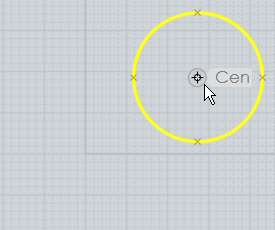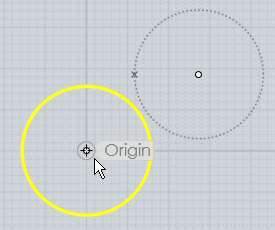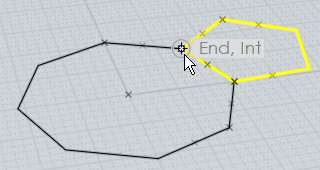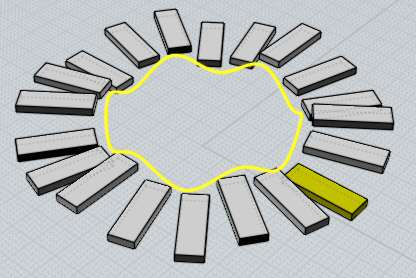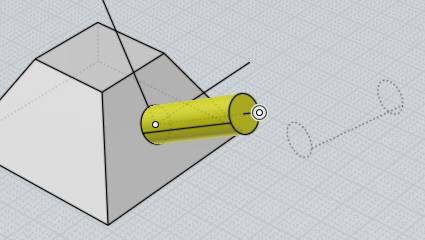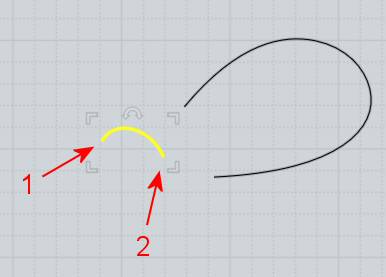 |
| Scale |
Scales objects around a center point.
This type of scaling is sometimes called a "Uniform" or "3D" scale since it scales equally in all axis directions.
To scale objects, first select the objects then run the Scale command. Next pick an origin point for the scale. This will be the fixed point which the objects will scale around. After you have picked the origin for the scale you can then either type in a number for the scale factor, or you can use the mouse to pick a scale factor.
When entering in a number for the scale factor, 1 represents no scaling. So for example:
2 will double the size of the object,
0.5 will shrink the object to one-half the original size,
10 will increase size by 10 times,
0.1 will shrink the object to one-tenth the original size,
etc...
You can set the scale factor using the mouse by picking 2 additional reference points. The relative distances of these points from the scale origin determines the scale factor. For example, if the second point is twice as far away from the origin as the first point, the scale factor will be 2.0 .
Example of scaling a rectangle using the mouse to set the scale factor:
After selecting the rectangle and running Scale, pick the center point for the scale, in this case the corner of the rectangle:

Next pick the first reference point. In a certain sense this point will calibrate the scale and set the distance that will correspond to a scale factor of 1. In this case the opposite corner of the rectangle was picked. Often times the first reference point may be snapped on to the perimeter of the object away from the scale origin:

Then the final reference point determines the scale factor, comparing its distance with the first distance. If you move the second reference point further away from the scale origin than the first reference point, the object will become larger:
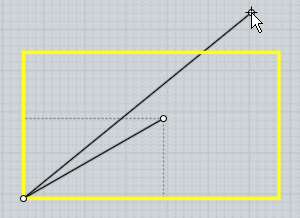
If you move the second reference point closer to the scale origin than the first reference point, the object will become smaller:
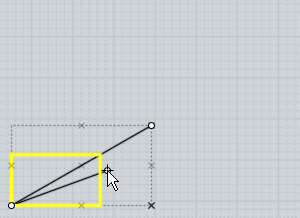
Scale works with reference points in this way to make it possible to snap points on to strategic areas to calculate scaling measured to existing objects. For example, say you want to scale up a rectangle by just the exact right amount so that it would touch an object above it. This is possible by careful picking of the reference points to measure the existing distance, and then the desired new distance. The proper scale factor for converting the existing distance into the desired distance will be calculated and applied to scale the object:




You can check the "Make copies" button or hold down the Ctrl key when clicking the last point to drop scaled copies of the object.
 |
| Scale 2D |
Scales objects around a center point, stretching them just in 2 axis directions.
Scale 2D works similar to Scale except the scaling is not applied in all directions, it is only applied in one 2D plane. The plane used depends on which viewport the origin point is picked in, so you will get a different effect if you pick in the Top view versus the Front view for example. The directions used correspond to the x and y axes of the viewport's grid.
See regular Scale for details on how the reference points work.
Example of scaling a cylinder with Scale 2D. The cylinder is widened in the x/y plane, but its height remains fixed:


 |
| Scale 1D |
Scales objects along a single direction.
Scale 1D is similar to scale, except the scaling is only applied in one direction. The direction is defined by the line between the origin and the first reference point.
See regular Scale for details on how the reference points work.
Example of scaling a circle into an ellipse along a diagonal:


Scale 1D can be used to stretch or compress an object to a new height while leaving its shape unchanged in X and Y. For example, here a piece is stretched in z by picking the scale origin at the bottom of the piece, the first reference at the top of the piece directly above scale origin (this forms a line going along the z axis which will be used as the scaling direction), and then the final reference point at the new height above it.


In the previous example, picking the final point lower than the first reference point would result in the piece squishing down to be shorter instead.
